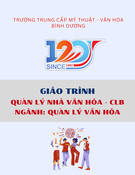
Confucius Institute project:
China’s cultural diplomacy
and soft power projection
Su-Yan Pan
Department of Social Sciences, The Hong Kong Institute of Education,
Hong Kong, People’s Republic of China
Abstract
Purpose – The purpose of this paper is to apply the theory of cultural diplomacy to explore
and explain the role and function of the Confucius Institution project and its implications for
understanding of China’s soft power projection.
Design/methodology/approach – This paper first presents the theories of soft power and cultural
diplomacy as an analytic framework. It then delineates an interpretative illustration of the CI project as
a platform for China’s cultural diplomacy. The paper concludes with a discussion of the CI project’s
implications for understanding of China’s soft power projection.
Findings – The paper argues that the Confucius Institute project can be understood as a form of
cultural diplomacy that is state-sponsored and university-piloted, a joint effort to gain China a more
sympathetic global reception. As such, the Confucius Institution project involves a complex of soft
power techniques. However, it is not entirely representative of soft power capability, because the
problems embedded in the project and in the wider society run counter to the Chinese government’s
efforts to increase the Confucius Institutions’ attractiveness and popularity.
Originality/value – This article sheds light on Chinese universities in the role of “unofficial cultural
diplomats.” On this topic, further research may need to explore more fundamental issues that bear
far-reaching significance and impact, i.e. the mechanics of Chinese university involvement in
Confucius Institutes. Interesting questions arising from this study may help open up a wider spectrum
of research topics for understanding the university-state relationship, cross-border higher education,
as well as the possibilities and limits of educational globalization. At this stage, this article serves as
a start to move scholarship in that direction.
Keywords Confucius Institute, Cultural diplomacy, Soft power, China, Universities,
National cultures
Paper type Research paper
Introduction
Between November 2004 and August 2011, the People’s Republic of China (PRC)
established a total of 353 Confucius Institutes (CI) and 473 related Confucian
classrooms in 104 countries and regions (Chinese Language Council International,
2011a), aimed at “developing Chinese language and culture teaching resources and
making [Ministry of Education] services available worldwide, meeting the demands of
overseas Chinese learners to the utmost degree, and contributing to global cultural
diversity and harmony” (PRC Ministry of Education, 2012). However, the explosive
growth of CIs generated heated discussions and debates regarding their purpose,
function and the hidden agenda behind the public vision statement. Much attention has
been given to the question “Does the expansion of Confucius Institutes represent the
rise of China’s soft power?”
The current issue and full text archive of this journal is available at
www.emeraldinsight.com/2046-3162.htm
Asian Education and Development
Studies
Vol. 2 No. 1, 2013
pp. 22-33
rEmerald Group Publishing Limited
2046-3162
DOI 10.1108/20463161311297608
The author expresses her gratitude to the anonymous reviewers for their constructive and
insightful comments. However, the author alone is responsible for any mistakes it may contain.
22
AEDS
2,1

A great number of researchers (e.g. Nye, 2005; Kurlantzick, 2007; Gil, 2009; Paradise,
2009; Ren, 2010; Yang, 2010) have employed the theory of soft power to guide their
inquiries into this question; however, they neither explore nor explain the rationale and
dynamics underpinning the PRC state’s diplomatic concern over the CI project’s name,
administrative structure, operations and functions. This study applies the theory of
cultural diplomacy (Cummings, 2003; Cull, 2008) to approach these issues. It provides
a supplement to existent literature by filling in the details about how soft power
policies are carried out in practice, arguing that the CI project can be understood as
a form of cultural diplomacy that is state-sponsored and university-piloted. As such,
the CI project involves soft power techniques, but not full soft power capability,
because the problems embedded in the CI project and in the wider society run counter
to the Chinese Government’s efforts to increase the CIs’ attractiveness and popularity.
To argue this, this paper first presents the theories of soft power and cultural
diplomacy as an analytic framework. It then delineates an interpretative illustration of
the CI project as a platform for China’s cultural diplomacy. The paper concludes with
a discussion of the CI project’s implications for our understanding of China’s soft power
projection.
Soft power, cultural diplomacy, and CI project
Soft power theory has been in a great number of discussions and debates (e.g. Nye,
2005; Kurlantzick, 2007; Gil, 2009; Paradise, 2009; Ren, 2010; Yang, 2010) to explore and
explain the role and function of the CI project. According to Joseph Nye (1990), who
coined the term, “soft power” refers primarily to ways in which a nation’s cultural
resources constitute a form of power that enhances, or even substitutes for military
and economic strength. The term can be seen as an extension and development of
Carr’s (1954) idea of “power over opinion” and Lukes’ (1974) “third dimension of
power,” both of which shed light on how the attractiveness of a nation’s culture, ideals,
policies, education and diplomacy give it the capacity to persuade other nations to
willingly adopt its goals. The essential part of soft power, as Nye (2004) explains, is the
ability to obtain what one wants through co-option and attraction rather than through
coercion or payment. Examples of soft power include the attraction of normative
values, media, business practices, education, and language.
Nye (2005) regards that the rapid expansion of CIs, along with the increasing
popularity of Chinese novels and films, the growing number of Chinese players in the
US National Basketball Association and the success of the 2008 Beijing Summer
Olympics, as an indication of the rise of China’s soft power. He warns the US
Government that, “although China is far from America’s equal in soft power, it would
be foolish to ignore the gains it is making.” Kurlantzick (2007) considers CIs and related
cultural and educational exchange activities as soft power techniques used by China to
woo the world with a “charm offensive.” However, a critical political commentary by
Ren (2010) notes that, despite their rapid worldwide growth, CIs have played a limited
role in extending China’s soft power due to operation problems, such as a shortage of
professional teachers and quality teaching programs. Paradise (2009) argues that
judging the CIs from the standpoint of expanding Chinese soft power may be the
wrong standard for measuring their success, because the real beneficiaries of the CI
project could be Chinese universities, which can, through CIs, expand their contacts
and exchanges with foreign academic institutions. Based on empirical studies on how
CIs enable Chinese universities to develop international exchanges and cooperation
with their international peer institutions, Yang (2010) suggests that CIs can be seen as
23
Confucius
Institute project

a new form of internationalization in Chinese higher education, one which represents
China’s projection of soft power in international higher education community. However,
it is important to note that internationalization of Chinese higher education is a double-
edged sword. On the one hand, it helps Chinese higher education gain international
recognition for its delivery of educational services in the global market and expand
Chinese influence worldwide, according to Zhou (2006), the PRC Minister of Education
between 2003 and 2009. On the other hand, it has been a cause for anxiety in other
countries about getting schooled by Beijing’s indoctrination (Little, 2010). For example,
a policy directive, dated May 17, sent by the US Department of State to universities
that sponsor Confucius states that any academics at university-based institutes who
are teaching at the elementary- and secondary-school levels are violating the terms of
their visas and must leave at the end of this academic year, in June (US Department of
State, 2012). Behind this seemly practical issue is the political concern that CI are a key
piece of the Chinese Government’s diplomatic outreach to wield power, even in its
softer variants (BBC Reporter, 2012; Fischer, 2012).
The theory of soft power and the aforementioned studies provide useful perspectives
on the CI project and its impact on China’s standing on the international stage. However,
they neither explore nor explain three important questions raising from a historical
review of the CI project:
(1) Why were the institutes were named after Confucius, who was reviled by
Communist leaders throughout the twentieth century?
(2) Since the teaching of Chinese abroad dates back to the 1987 establishment of
the Chinese Language Council International (Hanban), in what aspect does the
CI project differ from previous Chinese language teaching projects?
(3) Given that the CI project is governed and financed by the Chinese Government,
why do Chinese universities do most of the work to open new CIs?
Recent studies on cultural diplomacy could be an appropriate analytic framework for
analyzing and understanding these phenomena. Cultural diplomacy has a long history
as a means of promoting a country’s soft power (Nye, 2008; Hartig, 2012). According to
Milton C. Cummings (2003, p. 1), who offers a starting definition of the concept, cultural
diplomacy can be generally defined as “the exchange of ideas, information, values,
systems, traditions, beliefs, and other aspects of culture, with the intention of fostering
mutual understanding.” The purpose of cultural diplomacy is related to “an actor’s
attempt to manage the international environment by making its cultural resources and
achievements known overseas and/or facilitating cultural transmission abroad” (Cull,
2008, p. 33). Recent research undertaken by the Berlin-based Institute of Cultural
Diplomacy (2011a) has identified a number of forms of cultural diplomacy used by
different groups for different purposes. Examples include:
(1) state-sponsored cultural diplomacy, which is often used by governments for
distinct political purposes;
(2) independent or semi-independent cultural diplomacy institutions, such as the
British Council and the Goethe Institute, which take an informative and
exchange-based approach to the promotion of national culture; and
(3) potential cultural diplomacy channeled by academic institutions or individual
artists, academics or professionals involved in academic exchanges and
cooperation.
24
AEDS
2,1

From this perspective, the CI project could be understood as a form of cultural
diplomacy intended to facilitate economic connection, cultural dialogue, and political
trust between China and the rest of the world, as the following sections explain.
CI project as the state-sponsored and university-piloted cultural diplomacy
The CI project can be seen as a form of cultural diplomacy that is state-sponsored and
university-piloted, based on the project’s overall rationale, its close ties to the state,
diplomatic concerns over the name given the institutes, the use of CIs to showcase
the PRC’s diplomacy and foreign policy and the use of Chinese universities to link the
CI network around the world.
Rationale for the CI project
The rationale for the CI project reflects the PRC’s recognition of language teaching as a
means of building relationships, enhancing socio-cultural understanding and
promoting trade and foreign investment. Following its economic reforms and its
opening to the west, China worked to increase economic opportunities and attract
much-needed foreign investment. However, the state realized that foreigners’ lack of
Chinese language proficiency and understanding of Chinese culture were barriers that
hindered foreign direct investment in China. Beginning in 1987, in an effort to reduce
these barriers, the state dispatched Chinese language teachers to foreign countries
and established the Chinese Language Council International (Hanban) to administer
and support, under the guidance of the Ministry of Education, Chinese language
programs abroad (Chinese Language Council International, 2007). Since then, Hanban
has launched several initiatives to facilitate the teaching of Chinese language in foreign
countries, including preparing teachers to teach Chinese to non-Chinese speakers,
developing Chinese language teaching materials and establishing radio-, television-
and internet-based Chinese language distance education programs (The Office of
Chinese Language Council International, 2007).
In 2004, Hanban launched the CI project for the purpose of “developing Chinese
language and culture teaching resources and making its services available worldwide,
meeting the demands of overseas Chinese learners to the utmost degree, and
contributing to global cultural diversity and harmony” (Ministry of Education,
2012). According to Hanban, China’s increased engagement in the global economic
community led to increased international demand for learning Chinese language and
culture. Based on the experiences of British Council, the Alliance Franc¸aise, Spain’s
Instituto Cervantes and Germany’s Goethe Institute, therefore, China decided to open
its own chain of institutes to promote Chinese language and culture internationally
(Chinese Language Council International, 2011a). This explanation shows the PRC
state’s recognition of the cultural dynamics of other countries and its willingness to
engage in an international dialogue that may lead to collaboration. Such recognition
and willingness to facilitate cultural understanding when engaging in dialogue are
important elements of cultural diplomacy (Institute of Cultural Diplomacy, 2011b).
However, while other countries’ national cultural diplomacy institutions were
independent or semi-independent, China’s CI maintained close ties to the state.
Close ties between CIs and the state
The CIs are an extension of state administration tasked with conducting cultural
diplomacy, as can be seen from their administrative structure and financial resources.
The project’s headquarters are in the Hanban offices in Beijing, the political heart
25
Confucius
Institute project

of the PRC. When Hanban was first set up, it was a Chinese language education agency
governed by the Ministry of Education alone; as the years passed, however, the state
gradually expanded Hanban’s functions to include cultural exchanges and placed it
under the joint governance of 11 different ministries and commissions collectively
responsible for education, culture, foreign affairs and strategic planning for long-term
national development. For example, the Ministry of Culture and the Ministry of Foreign
Affairs are responsible for how Hanban communicates with foreign governments,
liaises with various organizations, associations and educational institutions run by
overseas Chinese and co-ordinates with Chinese diplomatic missions abroad to
facilitate the establishment and development of CIs worldwide. In addition, under the
instruction and supervision of the Ministry of Foreign Affairs, Hanban provides
Chinese language training for foreign embassies, United Nations representatives and
other international organizations, and foreign journalists in Beijing. Thus, Hanban is
one link in the chain of state administration tasked with cultural diplomacy.
Under this governance structure, CIs are not independent institutions, but agents
of the state; Hanban’s chairman, Li Yandong, is also a PRC state counselor, thus
ensuring the state’s close, high-level supervision of CIs. In addition, the state,
through the Ministry of Education (2012), provides massive financial support to
cover CI expenditures worldwide, including US$150,000 in start-up funds for each CI
and 50 percent of their operation and development costs; the remaining 50 percent
is borne by the host institutions. In 2010, the PRC allocated Renminbi 800 million
(roughly US$127 million) to support CIs worldwide (Chinese Language Council
International, 2011b).
Diplomatic concern over the name
The CI were named after the Chinese philosopher Confucius (551-479 BCE),
a somewhat surprising choice, given that Confucius had been reviled by the PRC’s
Communist leadership throughout the twentieth century. Education in China has
been an outgrowth of Confucian ethics and values since Confucius established the
country’s first school, ca. 521 BCE; by the time of the Qing Dynasty, the main goal
of Chinese educational institutions was to impart Confucian ethics and values
(Cai, 1994). Because of this historical legacy, Confucius is often seen as the symbol of
the long history of Chinese civilization. When the Nationalist Kuomintang
government centralized governance of the national education system, in 1929, then
President Chiang Kai-shek (1943) prescribed the Confucian moral precepts of
“loyalty, filial piety, humanity, love, faithfulness, harmony, and peacefulness (zhong,
xiao,ren,ai,xin,yi,heping)” as guiding principles for educational institutions
throughout the country.
However, The New Culture Movement (1912) led by pioneers of the Chinese
Communist Party, such as Li Dazhao and Hu Shi, called for a revolution against
Confucianism because of its failure to address China’s current problems and transform
China into a modern society, and its replacement with a new Chinese culture based on
democracy and science. After coming to power in 1949, the Communist Party of China
(CPC), in an effort to create an ideal educational environment for the promotion of
socialism, initiated ideological remolding movements that denounced Confucianism for
its association with feudalism and with education under the Kuomingtang. The anti-
Confucianism movement reached its peak in the “Criticize Lin Bao and Confucius”
campaign (1973), during the Cultural Revolution (1966-1976) (Chinese Education
Yearbook Editorial Board, 1949-1981, 1984).
26
AEDS
2,1


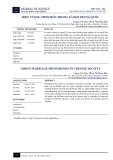

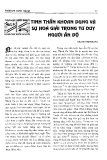
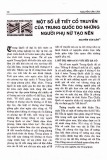



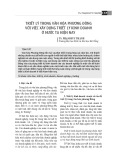
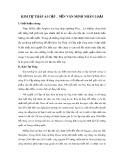
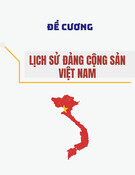


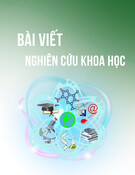
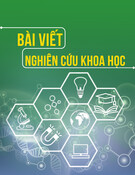


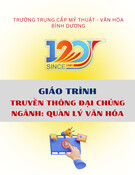

![Giáo trình Tổ chức và Quản lý Hoạt động Văn hóa Thông tin Cơ sở (Ngành Quản lý Văn hóa - Trung cấp) - Trường Trung cấp Mỹ thuật - Văn hóa Bình Dương [Mới nhất]](https://cdn.tailieu.vn/images/document/thumbnail/2025/20251110/kimphuong1001/135x160/17861762748492.jpg)
